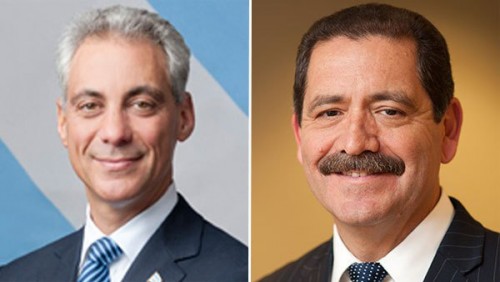Rahm Emanuel, the brash former congressman and top White House aide, easily won his bid to become Chicago’s mayor in 2011. Keeping that seat is proving to be far more difficult.
Emanuel has faced an unexpectedly tough runoff election campaign against Jesus “Chuy” Garcia, a previously little-known Cook County commissioner who earlier this month won the endorsement of the powerful Service Employees International Union. His surprising popularity is rooted in his ties to many of Chicago’s working class neighborhoods.
Tuesday’s runoff was forced after Emanuel failed to get at least 50 percent of the vote in February election, the first time Chicago has ever needed a mayoral runoff vote. The Chicago Tribune described Emanuel’s failure to capture the necessary 50 percent as “a national embarrassment.”
To put this in perspective, Emanuel’s predecessor, Richard M. Daley, ran the city from 1989 through 2011, never facing significant opposition. His father, Richard M. Daley, served as mayor from 1955 until his death in 1976.
Some see the runoff as a possible precursor to the 2016 presidential election, testing the appeal of populist candidates like Garcia. Said Time:
Garcia’s unexpected success story has become a national rallying cry for liberals who would like to see a candidate challenge (Hillary) Clinton, the former Secretary of State and presumed Democratic nominee, from the left. Like Emanuel’s critics, the activist left sees Clinton as too centrist, too compromising and too cozy with Wall Street and big banks.
Emanuel held a 15.8 percentage point lead over Garcia in a weekly poll released on March 29. But he is still seen as vulnerable in a campaign where Garcia has portrayed him as a supporter of big business and the wealthy North Side, while being out of touch with average families.
Garcia was preferred by 61 percent of Latino voters according to a recent poll conducted by several Latino groups. Latinos make up about 17 percent of Chicago’s registered voters. Sylvia Puente, executive director of Latino Policy Forum, said:
We know that this is likely to be a very close and competitive election. That 17 percent of Chicago’s electorate can make a difference.”
The famously combative and profane mayor also has been criticized for the way he’s handled a variety of issues bedeviling Chicago, including crime, the city’s pension crisis, and his closing of nearly 50 schools, mainly in black and Latino neighborhoods.
And he has come under criticism for financing his mayoral campaigns with large donations from wealthy people who do business with the city.
Garcia has painted Emanuel as being too cozy with the wealthy and corporate interests. But Emanuel has defended his focus on business, saying Chicago has added 73,000 jobs and attracted 30 corporate headquarters to the city since becoming mayor. Those headquarters include agriculture giant Archer Daniels Midland, baby formula maker Mead Johnson Nutrition and smart phone manufacturer Motorola Mobility.
Campaign donation totals change daily, but here’s a look at what each candidate has done.
Emanuel has raised about $20 million in his bid for re-election. Garcia, by contrast, has raised less than $3 million.
Emanuel’s top contributor in the runoff race is Ken Griffin, a billionaire Chicago hedge fund manager and reportedly the richest man in Illinois. Griffin has donated a total of $750,000 to Emanuel’s campaign and an independent Super PAC that supports the mayor.
The full list of Emanuel’s contributors since his first mayoral campaign in 2011 and their connections to city business can be found here.
Garcia’s top five contributors are labor unions. The American Federation of Teachers PAC has given Garcia $350,000 in the runoff election cycle, while the SEIU Healthcare Illinois Indiana PAC has donated $318,619.
The full list of Garcia’s contributors in the February and April runoff election cycles can be found here.
Next, let’s look at where their voting support lies.
Four years ago, Emanuel won the mayor’s race with 55 percent of the vote. But his popularity has slipped throughout much of the city.
An interactive map produced by the New York Times shows that Emanuel’s vote totals in the Feb. 24 election fell in more than 80 percent of the city’s 2,069 precincts compared to the 2011 election.
Garcia captured 54 percent of the vote in majority Latino precincts in the February election, compared to 39 percent for Gery Chico, the second-place finisher in the 2011 election.
Emanuel won a majority of the white vote in the February election, but even his popularity among those voters has slipped in the February election, the Times map showed.
Mr. Emanuel has his strongest base among predominantly white voters, particularly on the city’s North Side. But even his support in majority-white precincts waned to 53 percent from 59 percent four years ago. About a third of these voters went for Mr. Garcia in February.
Black voters could determine the outcome of the April 7 runoff, the Times said. Four years ago Emanuel captured 59 percent of the vote in predominantly black precincts. But even with the support of President Barack Obama, his vote percentage plunged to 42 percent in the February election.
After his weak performance in February, Emanuel has been trying to show a softer side. He recorded a campaign ad in which he acknowledged, “I can rub people the wrong way, or talk when I should listen.”
In the ad, Emanuel also tried to appeal to low-income voters by saying he fought business interests opposed to Chicago’s new minimum wage, which will rise to $13 an hour by 2019.
A win by Garcia on April 7 would still be seen as a huge upset. But missteps by Emanuel have made it possible.
STORY IDEAS
Who will decide Chicago’s runoff election?











